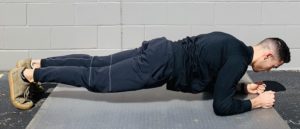Isometric Workouts

Read Time: 1 min 38 sec
Most Americans do not need to be told that exercise is good for their health. We know we should exercise, but sometimes we choose not to. According to the Centers for Disease Control and Prevention, only 24% of Americans meet the recommended Physical Activity Guidelines, and 1 out of every 4 engage in no exercise at all. So, what is holding us back?
Lack of time is one of the most commonly reported barriers to physical activity. With other responsibilities at work and home, exercise may end up near the bottom of your priority list. Not to mention, the jobs in the United States have become increasingly more sedentary, requiring employees to sit for 7 or more hours a day. But there is one type of exercise that you can do at any moment, in any location, wearing any clothing, and without any equipment. Those exercises are called isometric.
During an isometric exercise, the muscles are tensed or contracted without any movement (i.e., the muscles do not get shorter or longer). A plank is an example of an isometric hold. The proper form for this exercise is to tightly squeeze your core and leg muscles to maintain a flat back and stiff torso. Strength outcomes are typically greater when an exercise activates multiple muscle groups. But isometric exercise can focus on single muscles, too. The key point to remember is that any muscle that is regularly exercised remains healthy, and muscle that is not exercised tends to weaken and atrophy. Adding isometric training to your workout routine will help maintain strength and compliment your existing strength-building routines. It may also improve stability and overall posture.
The greatest advantage of isometric holds is that you can discreetly perform them anytime. This gives you the freedom to exercise at your desk, on a Zoom call, or in line at the grocery store without anyone even knowing. Start by contracting a muscle group, such as your abs or glutes, and hold for 30 seconds. Progress gradually to increase the hold to 60 seconds, 90 seconds, and eventually a full 2 minutes.
Based on the low-impact nature of isometric holds, these exercises may be well suited for individuals with arthritis, existing injuries, or other physical limitations. However, always check with your doctor before starting any new exercise program.
Isometric workouts are not intended to replace aerobic exercise. The Physical Activity Guidelines for Americans recommends healthy adults aim for 150 minutes of moderate-intensity aerobic exercise each week.
Next Article: National Immunization Awareness Month
